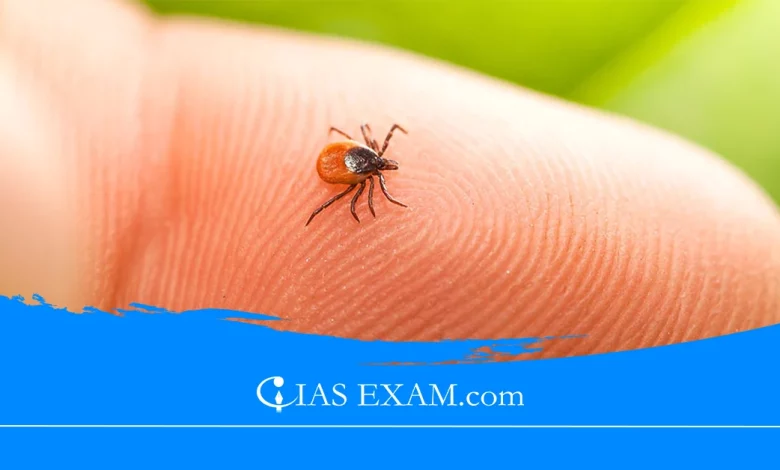
Context
The district of Ernakulam has recently witnessed an outbreak of Lyme disease.
Background of the Outbreak
- There has been a reported case of Lyme disease in Koovappady, Ernakulam district, which is believed to have been caused by a tick bite carrying the borrelia bacteria.
- The recent outbreak in Ernakulam marks a significant public health challenge. Initial cases were reported several weeks ago, with the numbers rising steadily.
- The affected areas include both urban and rural regions, indicating a widespread issue.
- Local health departments have been swift in their response, setting up special camps for diagnosis and treatment.
Details about Lyme Disease
About
Lyme disease, caused by the bacteria Borrelia burgdorferi, is primarily transmitted to humans through the bite of infected ticks. Originating in Lyme, Connecticut, this disease has since become a global health concern. In India, while Lyme disease has been relatively rare, the changing ecological landscape has led to an increased number of cases.
Symptoms of Lyme Disease
Early-Stage Symptoms
- Erythema Migrans (Rash): Most times it is the onset of the infection that patients notify to the physician, and the duration of the infection period is 3 to 30 days after tick bite. Usually, all-over a red rash, which can show the appearance of a bull’s-eye.
- Flu-like Symptoms: Common symptoms are fever, chills, general weakness, pain in different body parts, and headache, with one added to be neck stiffness.
- Swollen Lymph Nodes: The organic antioxidants included help to fight infections at the bite site.
Late-Stage Symptoms
- Joint Pain: It sometimes happens so that the infected arm or leg can continue to feel intense inflammation and soreness, sometimes for weeks, months, or even years, even after the fever goes down.
- Heart Issues: On one rare occasion, Lyme disease may be the trigger for an abnormal heart rhythm.
- Other Symptoms: Varies from mild to acute symptoms, like headaches, chest pain, shivers, and jaundice with blurred vision.
Diagnosis of Lyme Disease
- History of Tick Exposure: Shaped up in endemic locations yet supplemented by the private sector. Prior history of the patient going outdoors, including possible tick bites is taken into account.
- Enzyme-linked Immunosorbent Assay (ELISA) Test: The key advantage of this assay is its ability to detect antibodies produced for Borrelia burgdorferi. This test is most widely applied, though sometimes it may show different results from the disease diagnosis.
- Western Blot Test: Generally it fails only to be combined with ELISA for positive diagnosis. The purpose of this assay is to diagnose the presence of antibodies to proteins belonging to several species of Borrelia burgdorferi.
Treatment
Standard Treatment Protocols
- At the initial stage, oral medication like doxycycline, amoxicillin, or cefuroxime may be utilised. In a more advanced state, or severe forms, intravenous antibiotics would most probably be given. The time period of medication may be different ranging from 2 weeks’ to several weeks’ on the basis of disease stage and severity.
Long-Term effects
- Usually individuals with Lyme disease experience complete detection and recovery through optimal antibiotic treatment. Although some lights and pains will persist for a long time after treatment, the period goes away in a few weeks or even months. This condition is referred to as Post-Treatment Lyme Disease Syndrome (PTLDS). The mechanism of PTLDS remains unclear, but the symptoms usually arise from the residual tissue damage. Yet, they could be caused by many factors rather than the continuation of infection.
Future Outlook
This outbreak has triggered an increased focus on vector-borne diseases in Ernakulam. Health authorities are emphasising ongoing surveillance and research to better understand the patterns and control of Lyme disease. This includes studying tick populations and investing in developing effective vaccines.
Source: The Hindu
UPSC Prelims Practice Question
Q. Consider the following statements about Lyme disease
- Lyme disease is a bacterial infection transmitted through mosquito bites.
- It is prevalent predominantly in temperate forested regions of North America and Europe.
- The characteristic symptom of Lyme disease is a skin rash, often resembling a bull’s-eye pattern, accompanied by fever, headache, and fatigue.
- There is no known cure for Lyme disease, but symptoms can be managed with antibiotics.
Which of the statements given above are correct?
a. 1 and 2 only b. 2 and 3 only
c. 1, 2, and 4 only d. 3 and 4 only
Ans – “b”





.png)



